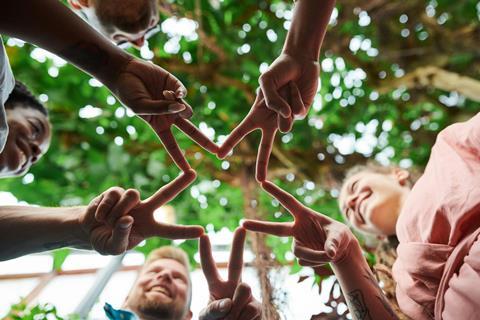Friends tend to share common interests, tastes, lifestyles, and other traits, but a new Yale-led study demonstrates that similarities among buddies can also include the makeup of the microbes lining their guts.

The study, published Nov. 20 in the journal Nature, examined the relationship between the structure of people’s social networks and the composition of their microbiomes — the bacteria and other microorganisms inhabiting individuals’ gastrointestinal tracts.
For the study, the researchers combined comprehensive mapping of the social networks of 1,787 adults living in 18 isolated villages in Honduras with detailed microbiome data from each participant; the vast database included 2,543 microbial species and 339,137 different strains — close genetic variants of the same species that share some features not found in other members of the species.
They found that people connected through a variety of relationship types — including non-familial and non-household connections — exhibit similarities in their microbiomes that go beyond what one would expect through chance.
Microbiome sharing
“We found substantial evidence of microbiome sharing happening among people who are not family and who don’t live together, even after accounting for other factors like diet, water sources, and medications,” said co-lead author Francesco Beghini, a postdoctoral associate at the Human Nature Lab at Yale. “In fact, microbiome sharing was the strongest predictor of people’s social relationships in the villages we studied, beyond characteristics like wealth, religion, or education.”
READ MORE: Taking pre- and probiotics could boost sensitivity to fairness, study suggests
READ MORE: Gut microbes drive brain circuit pruning for social development in zebrafish and mice
The highest amount of microbial sharing occurred among spouses and people living in the same households, but the researchers also observed elevated rates of sharing among other connections — including friends, or even second-degree social connections (such as friends of friends). Furthermore, people in the center of the social networks were more similar to the rest of the villagers than people at the social periphery, in keeping with a social flow of microbes across network ties within the villages.
The frequency with which people spend time together, including how often they share meals or how they greet each other — whether with handshakes, hugs, or kisses — was also associated with an increase in microbial sharing.
Social networks
At the same time, the researchers observed less microbial sharing between people residing in the same village who lacked social relationships with each other. And they saw even less sharing among individuals who lived in separate villages.
Two years after the initial data collection, the researchers remeasured the microbiomes of a subset of 301 participants from four of the villages. They found that the individuals among this subset who were socially connected had become more microbially similar that those who were not connected.
The researchers also discovered that clusters of microbial species and strains occur within groups of people within villages, meaning that social networks provide niches wherein individuals develop similar microbiomes to each other.
“Think of how different social niches form at a place like Yale,” said co-lead author Jackson Pullman, a 2023 Yale College graduate who was an undergraduate research assistant at the Human Nature Lab when the study was conducted. “You have friend groups centered on things like theater, or crew, or being physics majors. Our study indicates that the people composing these groups may be connected in ways we never previously thought, even through their microbiomes.”
Interconnections at microbial level
The findings have negative and positive implications, the researchers said. For example, they suggest that certain diseases or health conditions associated with the microbiome are more communicable than previously thought. But they also indicate that the benefits associated with having a healthy microbiome are transferable through social networks.
“What’s so fascinating is that we’re so interconnected,” said Pullman, who now manages an artificial intelligence startup he founded in the health-technology sector. “Those connections go beyond the social level to the microbial level.”
Study senior author Nicholas Christakis, Sterling Professor of Social and Natural Science in Yale’s Faculty of Arts and Sciences, directs the Human Nature Lab, which studies questions that lie at the intersection of the social, biological, and computational sciences.
Social contagion
“My lab is very happy to publish this paper, since it reflects the ongoing pursuit of an idea we articulated in 2007, namely, that phenomena like obesity might spread not only by social contagion, but also by biological contagion, perhaps via the ordinary bacteria that inhabit human guts,” said Christakis, who was the project’s principal investigator.
Additional co-authors are Marcus Alexander and Shivkumar Vishnempet Shridhar, both of the Human Nature Lab; Drew Prinster of Johns Hopkins University; Adarsh Singh and Ilana L. Brito of Cornell University; Rigoberto Matute Juárez of Soluciones of para Estudios de la Salud in Honduras; and Edoardo M. Airoldi of Temple University.
The research was supported by the NOMIS Foundation, with additional funding from the Rothberg Catalyzer Fund, courtesy of Jonathan Rothberg ’91.







No comments yet